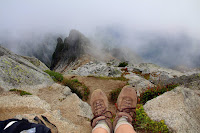 |
| Foggy Lake and Del Campo Peak from Gothic Peak, Gothic Basin 7/17/15 |
Overview:
This is another destination fantastic for overnight camping, although it is not a beginner backpacking trip like Goat Lake. Make no mistake, this trail can be punishing at times, especially in the summer heat--one can lose heart on the steep switchbacks in the more woodsy portion, especially if you are not careful to stay hydrated. The reward is great, though, and well worth the sweat. It is not the most difficult hike on Mountain Loop, and should not be last on your list.
There are plenty of spots to camp in the basin, although they are not always obvious upon entry. This actually makes for a pleasantly private sleep. You may be worried about noise if there are other parties camping around, but it is relatively easy to find seclusion among the hills in the basin.
The Trail:
If you look on a map for the Gothic Basin trail, you won't find it. Instead, look for Weeden Creek trail. After you park at Barlow Pass (which can become incredibly crowded on weekends during summer, so get there early), carefully cross Mountain Loop and start on the closed road to the abandoned historic mining town, Monte Cristo.
 |
| View of Silvertip Peak, Gothic Basin trail 3/14/15 |
After about a mile of easy, flat road following the Sauk River--years ago it was used by cars until the bridge across the river was washed out in floods--the trail will take a right, away from the river and into the forest. Take advantage of the outhouse here, because it is the only one you will find on the trail. Be sure to stay right and follow signs for Weeden Creek, not Monte Cristo (which is closed for the time being, anyway). Half a mile later, cross Weeden Creek and start your taxing uphill climb. After more forested walking, gaze on the Monte Cristo Range, most prominently red-and-green-and-often-snow-capped Silvertip Peak across the valley. The views will come and go as you traverse the side of the mountain.
Beware, as snow often lingers late into the season here. Keep a map with you at all times to keep track of your progress and be sure you haven't lost the trail if there is snow. Finally, climb over the ridge and into the Basin. You will first be greeted by the other-worldliness of the white rocks and tall peaks, babbling of snow melting and There is plenty to explore here. Though you won't see it when you first enter the basin, most people take a trip to Foggy Lake before anything else. Foggy Lake is to your right, over a big rocky hill at the base of Del Campo Peak, and it is blue and clean as anything. In summertime, Del Campo makes a worthy, if difficult and quite exposed next objective. Do not attempt this peak if you are very afraid of heights. Gothic Peak will be to your left if you are facing Del Campo, and is also climbable. If you go to the left when you first enter the basin you will find a cliff and a waterfall with Weeden Lake at the bottom.
 |
| Facing southeast toward Weeden Lake, Gothic Basin 3/14/15 |
Stats:
Difficulty--strenuous
Popularity--high [especially until Monte Cristo opens up again]
Mileage--9.2 round-trip
Highest Elevation--5200 ft
Elevation gain--2840 ft
Distance from I-5 in Everett--45 miles; 70 minutes
Major Peaks Visible: Del Campo Peak, Gothic Peak, Silvertip Peak and much of the Monte Cristo Range
http://www.wta.org/go-hiking/hikes/gothic-basin





































